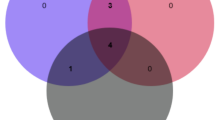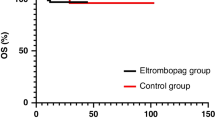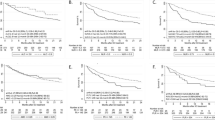Abstract
Background
In severe aplastic anemia (SAA), predictive markers of response to immunosuppressive therapy (IST) of porcine antilymphocyte globulin (pALG) have not been well defined. We investigated whether clinical and laboratory findings before treatment could predict response in a pediatric cohort.
Methods
In this study, we included 70 newly diagnosed SAA children and treated them with pALG. The response rate was documented during follow-up. The log-rank test compared response rates between the potential predictive factors.
Results
The response rate was 57.1% at 24 months follow-up. In log-rank test, mild disease severity was the most significant predictive marker of better response (P < 0.001); SAA patients with higher absolute reticulocyte count (ARC) and platelet level showed a higher response rate (both P < 0.001). Although insignificantly, elderly children and male sex show better response rate after treatment. The response rate worsened when the time interval before IST was more than 60 days.
Conclusion
Modified IST with pALG was suitable for SAA children, and favorable response correlates with mild disease severity was identified. ARC and platelet status also appeared to be a reproducible prognostic model for response rate. IST should be started as soon as possible, given that the response rate worsens as the interval between diagnosis and treatment increases.
Similar content being viewed by others

Log in or create a free account to read this content
Gain free access to this article, as well as selected content from this journal and more on nature.com
or
References
Young, N. S. Acquired aplastic anemia. JAMA 282, 271–278 (1999).
Dufour, C. et al. Outcome of aplastic anaemia in children. A study by the severe aplastic anaemia and paediatric disease working parties of the European group blood and bone marrow transplant. Br. J. Haematol. 169, 565–573 (2015).
Ma, X. et al. Comparison of porcine anti-human lymphocyte globulin and rabbit anti-human thymocyte globulin in the treatment of severe aplastic anemia: a retrospective single-center study. Eur. J. Haematol. 96, 260–268 (2016).
Cabannes-Hamy, A. et al. The effect of age in patients with acquired aplastic anaemia treated with immunosuppressive therapy: comparison of Adolescents and Young Adults with children and older adults. Br. J. Haematol. 183, 766–774 (2018).
Bacigalupo, A. et al. Antilymphocyte globulin, cyclosporine, prednisolone, and granulocyte colony-stimulating factor for severe aplastic anemia: an update of the GITMO/EBMT study on 100 patients. European Group for Blood and Marrow Transplantation (EBMT) Working Party on Severe Aplastic Anemia and the Gruppo Italiano Trapianti di Midolio Osseo (GITMO). Blood 95, 1931–1934 (2000).
Kojima, S. et al. Immunosuppressive therapy using antithymocyte globulin, cyclosporine, and danazol with or without human granulocyte colony-stimulating factor in children with acquired aplastic anemia. Blood 96, 2049–2054 (2000).
Rosenfeld, S. J., Kimball, J., Vining, D. & Young, N. S. Intensive immunosuppression with antithymocyte globulin and cyclosporine as treatment for severe acquired aplastic anemia. Blood 85, 3058–3065 (1995).
Frickhofen, N., Heimpel, H., Kaltwasser, J. P. & Schrezenmeier, H. Antithymocyte globulin with or without cyclosporin A: 11-year follow-up of a randomized trial comparing treatments of aplastic anemia. Blood 101, 1236–1242 (2003).
Peslak, S. A., Olson, T. & Babushok, D. V. Diagnosis and treatment of aplastic anemia. Curr. Treat. Options Oncol. 18, 70 (2017).
Luzzatto, L. & Risitano, A. M. Advances in understanding the pathogenesis of acquired aplastic anaemia. Br. J. Haematol. 182, 758–776 (2018).
Di, B. E. et al. Rabbit antithymocyte globulin (r-ATG) plus cyclosporine and granulocyte colony stimulating factor is an effective treatment for aplastic anaemia patients unresponsive to a first course of intensive immunosuppressive therapy. Gruppo Italiano Trapianto di Midollo Osseo (GITMO). Br. J. Haematol. 107, 330–334 (1999).
Scheinberg, P., Nunez, O. & Young, N. S. Retreatment with rabbit anti-thymocyte globulin and ciclosporin for patients with relapsed or refractory severe aplastic anaemia. Br. J. Haematol. 133, 622–627 (2006).
Scheinberg, P. et al. Horse versus rabbit antithymocyte globulin in acquired aplastic anemia. N. Engl. J. Med. 365, 430–438 (2011).
Bing, H. et al. The use of anti-human T lymphocyte porcine immunoglobulin and cyclosporine a to treat patients with acquired severe aplastic anemia. Acta Haematol. 124, 245–250 (2010).
Chen, M. et al. Long-term follow-up study of porcine anti-human thymocyte immunoglobulin therapy combined with cyclosporine for severe aplastic anemia. Eur. J. Haematol. 96, 291–296 (2016).
Wei, J. et al. Porcine antilymphocyte globulin (p-ALG) plus cyclosporine A (CsA) treatment in acquired severe aplastic anemia: a retrospective multicenter analysis. Ann. Hematol. 94, 955–962 (2015).
Liu, L. et al. Efficacy of porcine antihuman lymphocyte immunoglobulin compared to rabbit antithymocyte immunoglobulin as a first-line treatment against acquired severe aplastic anemia. Ann. Hematol. 94, 729–737 (2015).
Camitta, B. M. et al. Severe aplastic anemia: a prospective study of the effect of early marrow transplantation on acute mortality. Blood 48, 63–70 (1976).
Scheinberg, P. et al. Treatment of severe aplastic anemia with a combination of horse antithymocyte globulin and cyclosporine, with or without sirolimus: a prospective randomized study. Haematologica 94, 348–354 (2009).
Nishikawa, E. et al. Long-term outcomes of 95 children with moderate aplastic anemia treated with horse antithymocyte globulin and cyclosporine. Pediatr. Blood Cancer 64, e26305 (2017).
Kulagin, A. et al. Prognostic value of paroxysmal nocturnal haemoglobinuria clone presence in aplastic anaemia patients treated with combined immunosuppression: results of two-centre prospective study. Br. J. Haematol. 164, 546–554 (2014).
Tichelli, A. et al. A randomized controlled study in patients with newly diagnosed severe aplastic anemia receiving antithymocyte globulin (ATG), cyclosporine, with or without G-CSF: a study of the SAA Working Party of the European Group for Blood and Marrow Transplantation. Blood 117, 4434–4441 (2011).
Cui, Q. et al. Modified immunosuppressive therapy with porcine antilymphocyte globulin plus delayed cyclosporine A in children with severe aplastic anemia. Int J. Hematol. 107, 64–68 (2018).
Borowitz, M. J. et al. Guidelines for the diagnosis and monitoring of paroxysmal nocturnal hemoglobinuria and related disorders by flow cytometry. Cytom. B 78, 211–230 (2010).
Sugimori, C. et al. Minor population of CD55−CD59− blood cells predicts response to immunosuppressive therapy and prognosis in patients with aplastic anemia. Blood 107, 1308–1314 (2006).
Bacigalupo, A. How I treat acquired aplastic anemia. Blood 129, 1428–1436 (2017).
Yoshida, N. et al. Predicting response to immunosuppressive therapy in childhood aplastic anemia. Haematologica 96, 771–774 (2011).
Nissen, C. et al. Gender and response to antilymphocyte globulin (ALG) for severe aplastic anaemia. Br. J. Haematol. 83, 319–325 (1993).
Führer, M. et al. Immunosuppressive therapy for aplastic anemia in children: a more severe disease predicts better survival. Blood 106, 2102–2104 (2005).
Chang, M. H. et al. Predictors of response to immunosuppressive therapy with antithymocyte globulin and cyclosporine and prognostic factors for survival in patients with severe aplastic anemia. Eur. J. Haematol. 84, 154–159 (2010).
Socié, G. et al. Malignant tumors occurring after treatment of aplastic anemia. European Bone Marrow Transplantation-Severe Aplastic Anaemia Working Party. N. Engl. J. Med. 329, 1152–1157 (1993).
Acknowledgements
We would like to acknowledge AiYou Foundation and patients for participating in the follow-up as well as those who provided feedback on the written information. This work was supported by the National Key Research and Development Program of China (2016YFC0901503) and the National Natural Science Foundation of China (81500156, 81170470).
Author information
Authors and Affiliations
Corresponding author
Ethics declarations
Competing interests
The authors declare no competing interests.
Additional information
Publisher’s note: Springer Nature remains neutral with regard to jurisdictional claims in published maps and institutional affiliations.
Rights and permissions
About this article
Cite this article
Liu, LP., Chen, XJ., Yang, WY. et al. Predicting response to porcine antilymphocyte globulin plus cyclosporine A in children with acquired severe aplastic anemia. Pediatr Res 86, 360–364 (2019). https://doi.org/10.1038/s41390-019-0437-1
Received:
Revised:
Accepted:
Published:
Issue date:
DOI: https://doi.org/10.1038/s41390-019-0437-1


